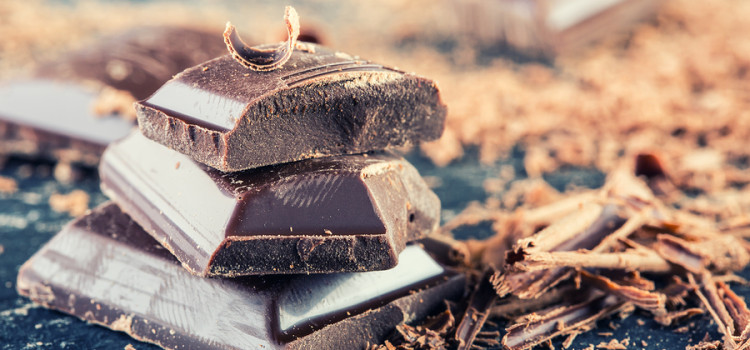Attention all chocolate lovers: True, chocolate has a lot of calories and fat – but it also has many nutritional benefits.
For example, it has been linked in studies to improved mood and energy and to contribute to a healthier heart.
It is no accident that chocolate has long been used to provide comfort to both body and soul!

Your brain on chocolate
According to a new study, the flavanol component of cocoa has been found to be beneficial in improving the cognitive function and reducing high blood pressure in the elderly patients who presented with symptoms of mild cognitive impairment. The study author Giovambattista Desideri, who is an associate professor of internal medicine and public health at the University of L’Aquila in Italy wrote that the study demonstrated that regular consumption of flavanols present in cocoa improves cognitive function. Hence, cocoa may be used as a complementary treatment strategy to manage patients with early dementia. This news comes on the tail of several others that found benefits to mood and memory in both animal models and humans.
Eating chocolate increases the blood flow to the brain, thereby improving the health of brain cells. The risk of stroke is also reduced by eating chocolate. Several chemicals, including phenylethylamine (PEA) are found in chocolate. This chemical is similar to the chemical that is produced by your brain when you fall in love. PEA may help your brain to increase the amount of endorphins released in the body, thereby making you feel happier.
Give your heart to chocolate
According to several studies, the risk of heart disease is reduced by consuming dark chocolate. Eating dark chocolate two to three times per week was noted to potentially aid in lowering high blood pressure. Further, the risk of atherosclerosis may be reduced by eating dark chocolate, and for this and other contributions, the blood flow to the heart may be improved and risk of clot formation reduced.
How sweet it is: chocolate can help to control blood sugar
The flavonoids present in dark chocolate may improve the body’s ability to use insulin effectively. This helps in reducing the development of insulin resistance, high blood sugar, type 2 diabetes, and the various serious medical conditions that come with it. Chocolate may also improve the health of your blood vessels and circulation, an additional layer of potential protection. Moreover, the glycemic index of dark chocolate is generally low, meaning that when eaten in moderation, it you may not experience spikes in blood sugar or fats (triglycerides).
As good as gold: chocolate is rich in phytonutrients and more
Phytonutrients are plant chemicals found to be beneficial to the body. Most act through antioxidant and anti-inflammatory properties. Antioxidants are substances that help in combating the effects of damaging free radicals, and are associated with aging of cells and also may be a possible cause of various diseases, including cancers and heart disease. Anti-inflammatory compounds are favored for strengthening the body’s cells and tissues, and – because obesity is an inflammatory condition – to exert potential benefits in weight management as well. Hence, eating foods that are rich in phytonutrients such as dark chocolate may protect against processes leading to the negative aspects of aging and risk of overweight.
Dark chocolate is also a source of a variety of vitamins and minerals, including copper, potassium, iron, and magnesium, all of which may help support your health. Copper and magnesium decrease the risk of stroke and cardiovascular disease, iron prevents the development of iron deficiency anemia, and magnesium helps in reducing the risk of high blood pressure, type 2 diabetes, and heart disease.
Choosing the best of the best
To get the most from your chocolate, it is important to look for some key factors:
1. High percent cacao/cocoa – 70% and above is considered ideal
2. Organic sources – to avoid harmful herbicides and/or pesticides that may be used in conventional chocolate production
3. No added fats – the natural ‘cocoa butter’ in chocolate beans provides plenty of fat to make a delectable product
4. Quality sweetener(s) – avoid fructose, refined sugar, or artificial non-caloric substitutes, and instead go for coconut sugar or nectar, organic whole cane juice, inulin (chicory root), monk fruit, Stevia, or xylitol.
5. Moderation! Though there are numerous health benefits associated with chocolate, it is still a very dense food, high in fat and often sugar, and so should be eaten in moderation.
One ounce or 28 grams of good quality dark chocolate yields an average of 10-12 grams of fat (5-7 grams saturated), 10-15 grams of carbohydrates, and 2-4 grams of protein, and if made with whole cacao/cocoa beans, may provide some fiber.
Still a treat
So- assuming you have the right kind of natural dark chocolate, and assuming you are eating it in moderation- then you can go ahead and treat yourself!
References
Grassi D, Socci V, Tempesta D, Ferri C, De Gennaro L, Desideri G, Ferrara M. Flavanol-rich chocolate acutely improves arterial function and working memory performance counteracting the effects of sleep deprivation in healthy individuals. J Hypertens. 2016 Jul;34(7):1298-308.
Grassi D, Ferri C, Desideri G. Brain Protection and Cognitive Function: Cocoa Flavonoids as Nutraceuticals. Curr Pharm Des. 2016;22(2):145-51.
Grassi D, Desideri G, Necozione S, Ruggieri F, Blumberg JB, Stornello M, Ferri C. Protective effects of flavanol-rich dark chocolate on endothelial function and wave reflection during acute hyperglycemia. Hypertension. 2012 Sep;60(3):827-32
Grassi D, Desideri G, Necozione S, Lippi C, Casale R, Properzi G, Blumberg JB, Ferri C. Blood pressure is reduced and insulin sensitivity increased in glucose-intolerant, hypertensive subjects after 15 days of consuming high-polyphenol dark chocolate. J Nutr. 2008 Sep;138(9):1671-6.
Grassi D, Necozione S, Lippi C, Croce G, Valeri L, Pasqualetti P, Desideri G, Blumberg JB, Ferri C. Cocoa reduces blood pressure and insulin resistance and improves endothelium-dependent vasodilation in hypertensives. Hypertension. 2005 Aug;46(2):398-405. Epub 2005 Jul 18.
Grassi D, Lippi C, Necozione S, Desideri G, Ferri C. Short-term administration of dark chocolate is followed by a significant increase in insulin sensitivity and a decrease in blood pressure in healthy persons. Am J Clin Nutr. 2005 Mar;81(3):611-4.




Do you have the links to the studies that prove this?
Hi, Razamgo. The references are listed at the end of the article, just before this comments section.
what types of beverages can you drink besides water. I have been drinking green tea, and water with the packets of flavoring or koolaid. I know water is best but are there any other drinks to have?
Hi, MissEarly. You can flavor water with natural additives such as squeezes of lemon or lime, steeping the peels or even cut up fruit or berries (like tea), then sweetening with high-quality natural options like Stevia and/or erythritol.
.my lunch meal is too repetitive. I dont really like cold cuts. I love chicken from the can with hellsman’s real mayonnaise to make a sandwich. I tried the with avocado…it has a strange taste. What should I do?
Hi, Allen0580. You can swap out items in your menu by clicking on the edit or crossout tool to the immediate right (let your mouse cursor hover over the area, and they will appear), then selecting an alternative from the pop-up list.
If you want to completely change the meal, then click on the edit tool to the upper right of the meal (toward the right end of the header), and you will be brought to an area in which you can select the foods you want from the searchable master food list. You will be guided by your meal pattern, which has been calculated to meet your nutritional needs and goals.
I would like more days with no cooking for the lunch meal. I usually have an egg or cooked breakfast, and prepare a cooked meal for evening. Preparing 3 meals are more time consuming than I want. It seems like all I do is plan and prepare.
Hi, secazzel. I suggest you try the personal version of the Menu Planner application, so that you can select the foods that work for you at the respective menus.
Hi , a question ,I’m lactose intolerant ,,the chocolate for me is horrible , have you got any products I can try please ??? since trying the lactose chocolate it’s put me off chocolate all together , they may be good thing .
thanks wait for your comments and suggestion.
Angie
Hi, Angie. Vegan chocolates will be 100% milk free. The most popular UK-based brand is Moo-Free, but there are others out there. A dark chocolate labeled “Kosher-Parve” will also be dairy-free.
i like, anne, find working in snacks a real problem. i don’t know if we are supposed to eat one or two of the food items listed in the snacks menu or all of them at one time. who has a good schedule for spacing them in. i am just plain not hungry between meals. if i ate them all, i would be eating all day,with time left for nothing else…..help!
Hi, LanePadgett. The intention is for you to eat all of the item on your menu. Most people are comfortable with about 2-1/2 to 3 hours between meals and snacks. If you’re not hungry of it it’s inconvenient, that’s fine. Just be sure to get any fruits/vegetables and high-calcium foods (dairy, tahini, etc.) at other meals so your basic nutrient needs are met. It’s great that you are in tune with your hunger cues!!!
Hi, I sometimes don’t have time to eat a snack, can I add it to the following meal or do I just skip it?
Hi, Anne. Sure – whatever works for you.
I am just starting and need all the encouragement I can get. I live alone and need meals that I can use for two or three days. If you have any suggestions let me know. Sandy bLekin
I’m surprised and somewhat disappointed that no health issue question were in the profile.
Hi, Marilyn. The profile is to calculate your most basic nutritional needs, and so will not be significantly affected by medical conditions that would still enable you to take on a weight loss program. Note that the nutritional principles here are already based on common medical conditions associated with overweight. In addition, our menu-building Menu Planner application is such that you select the foods, meaning you can omit whatever does not fit your condition. Finally, if your condition requires specific guidance, we have the community forums in which I participate and am happy to provide whatever assistance is possible.
I have low blood pressure…have a pacemaker and I’m supposed to increase my salt intake. Most of my life I avoided salt because of the constant advice to avoid it; however, that is not good for people who have low blood pressure. Certainly other issues caused the low blood pressure but salt is not always “The enemy”
That’s very true! Sometimes it’s the quality of the salt that’s important, too, hence the popularity of “wild” salts.
I feel very overweight and uncomfortable at the optimal goal weight you have for me. 130-135 feels much better.
I agree! Go for it.
Why picture a banana as one of five foods not to eat and then add it in the menus?
Hi, Denanjean. It’s definitely not one of the foods to avoid – it’s just a random photo that webhosts select. We have a few articles on the benefits of bananas (https://www.trimdownclub.com/?s=banana&cat=1).